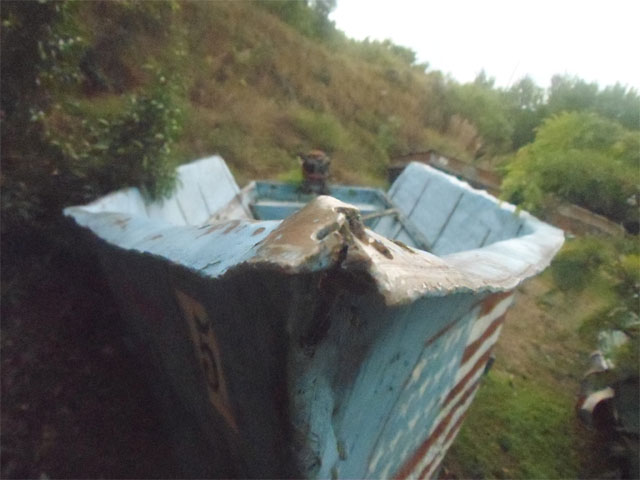Cuban Raft Exhibit Tells Stories of Freedom Seekers. By Daniel Rivero.

But since Fidel Castro’s Revolution succeeded in 1959, small boats have become a vehicle of escape for
hundreds of thousands of Cubans seeking freedom from the repressive communist government. Only 90
miles of sea separate the island from Florida Keys, and passing over the Straits of Florida has remained
one of the main passageways to freedom up to to this day.
Today, the Key West Botanical Garden has a display of eleven of these rafts that have been found and
retrieved over the years.
THE BOATS
This boat is the most recent arrival in the collection. It was found in 2010 on the Marquesas Islands, about
20 miles west of Key West. The ‘USGC-OK’ that is seen on the side of the boat indicates that those aboard
were retrieved legally by the Coast Guard under the Cuban Adjustment Act. Under the policy, those who set
foot on dry land can stay in the United States and apply for legal residency one year later.
All artifacts seen in the boat are original.


This boat arrived in Key West in 2008. The boat had a wheel system underneath, which would allow it to be
transported from where it was built to the ocean. Some suspect that it was built inside a house.
This boat was found in the mid to late 1980s, and is believed to be part of the historic Mariel boatlift of 1980 that
saw about 125,000 Cubans making the trip to the Florida Keys.
This boat was found on Boca Grande, about ten miles west of Key West. Notice the American flag painted on the
righthand side.
Through stories from those who made it to land, we know that several refugees who rode this boat were killed at
sea from shark attacks. The overpopulated boat hung low to the water line, but the ballast you see on the side
was to help keep them safe from these attacks.
This traditional Cuban fishing yacht arrived in 1985, and was used for many years locally. It arrived in Key West
from Mariel, Cuba. According to the Garden, the boat can be restored for further use, and they encourage
you to inquire about it.

This is a recovered boat engine. Impressively, the engine was actually made from lawn mower parts.

This is a Zodiac dinghy, filled with expanding foam.

In 2013, the Coast Guard’s Miami sector interdicted 1,535 Cuban rafters who had not yet reached land. These
individuals are repatriated to Cuba, and many of them face persecution upon arrival.
817 Haitians were interdicted on the water during the same year, along with 211 Dominicans, 33 Mexicans and
76 people from other countries.
Recently, the Coast Guard began a campaign asking Haitians in particular to not take to the seas in hopes of
reaching Florida.
In 1991, the United States agreed to issue 20,000 immigrant visas to Cubans each year, hoping that the
agreement would help asylum seekers reach the states by “safe, legal, and orderly channels.” Yet the balseros
still find a way.
Regular migration talks between the two countries, which have been on hold for two years following the arrest
of American Alan Gross, are set to resume this July. As the State Department notes, however, “This does not
represent any change in policy towards Cuba."
There are no diplomatic ties between Washington and Havana.
_________________________






